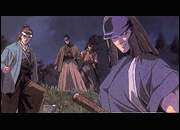

—by Charles McCarter
In the eleventh year of the Meiji Era (1878), a vagabond swordsman
is found wandering the streets of Tokyo. A strange man, he carries
a reverse-bladed sword and has an x-shaped scar on his cheek. He
wants only to be left alone.
 However, a girl named Kamiya Kaoru accuses him of being
the man claiming the identity of the legendary Hitokiri Battousai.
This man is murdering people in the name of her family's doujo.
When he saves her from the real killer, she invites him to come stay at
her doujo, since he obviously has no other place to go. This is the
beginning of the story of Himura Kenshin. However, a girl named Kamiya Kaoru accuses him of being
the man claiming the identity of the legendary Hitokiri Battousai.
This man is murdering people in the name of her family's doujo.
When he saves her from the real killer, she invites him to come stay at
her doujo, since he obviously has no other place to go. This is the
beginning of the story of Himura Kenshin.
 Before the Meiji Restoration, Himura Kenshin was known as
Hitokiri (Murderer) Battousai. He was the top assassin for the reformist
group Ishin Shishi. However, when the old government was overthrown and
the fighting had drawn to an end, Hitokiri Battousai had disappeared.
Kenshin wandered the countryside for nearly eleven years; the world
presumed him dead or lost. Before the Meiji Restoration, Himura Kenshin was known as
Hitokiri (Murderer) Battousai. He was the top assassin for the reformist
group Ishin Shishi. However, when the old government was overthrown and
the fighting had drawn to an end, Hitokiri Battousai had disappeared.
Kenshin wandered the countryside for nearly eleven years; the world
presumed him dead or lost.
 When Kenshin meets Kaoru, he is no longer Hitokiri Battousai, for
he has sworn never to take another life again. His sword is not a regular
sword, but a reverse-bladed sword, meaning that he cannot kill anyone
with his sword, but he can defend himself. Kenshin is a man who is trying
to escape his past, and create a future for himself. With the help of
Kaoru and the others that he meets, he may just have a chance. When Kenshin meets Kaoru, he is no longer Hitokiri Battousai, for
he has sworn never to take another life again. His sword is not a regular
sword, but a reverse-bladed sword, meaning that he cannot kill anyone
with his sword, but he can defend himself. Kenshin is a man who is trying
to escape his past, and create a future for himself. With the help of
Kaoru and the others that he meets, he may just have a chance.
THE KAMIYA DOUJO
Kaoru's doujo becomes a haven for the series regulars. After Kenshin's
arrival, he and Kaoru find themselves helping a boy named Myojin Yahiko.
Yahiko has been pressed into the service of a band of local thieves in order
to repay a debt. Kaoru goes to rescue him but finds herself outnumbered.
Kenshin shows up and rescues them both, gaining the admiration of the boy.
When he says he wants to be just like Kenshin, Kenshin replies he's not
interested in teaching anyone how to kill and tells him Kaoru should be his
teacher. Reluctantly, he agrees.
 Sanosuke's introduction to the doujo is somewhat less peaceful.
Incredibly strong, Sanosuke uses the giant Zanba sword, which was originally
designed to be used by horsemen. The sword proved too unwieldy to be used,
but Sanosuke's strength enables him to use it as a normal sword. When he
beats up some drunks at the local restaurant, he catches the attention of
several people. Sanosuke challenges Kenshin, but he declines. Meanwhile,
one of the other men from the bar hires him to kill Kenshin. After several
rounds of fighting, Kenshin wins, and Sanosuke tells him that he'll be
keeping an eye on him to see if he will really protect those he cares about.
Over time, the two gradually become friends. Sanosuke's introduction to the doujo is somewhat less peaceful.
Incredibly strong, Sanosuke uses the giant Zanba sword, which was originally
designed to be used by horsemen. The sword proved too unwieldy to be used,
but Sanosuke's strength enables him to use it as a normal sword. When he
beats up some drunks at the local restaurant, he catches the attention of
several people. Sanosuke challenges Kenshin, but he declines. Meanwhile,
one of the other men from the bar hires him to kill Kenshin. After several
rounds of fighting, Kenshin wins, and Sanosuke tells him that he'll be
keeping an eye on him to see if he will really protect those he cares about.
Over time, the two gradually become friends.
 The final member of the "family" is Megumi. A promising young
doctor, she is unknowningly working for another doctor who is providing opium
to the local crime lord. When the doctor is killed, the crime lord takes
Megumi prisoner, as she also knows how to make the drug. Ultimately, Kenshin
frees her from her forced employment and she becomes the neighborhood doctor,
providing medical assistance for not only Kenshin and the others but all the
people who live in the area. The final member of the "family" is Megumi. A promising young
doctor, she is unknowningly working for another doctor who is providing opium
to the local crime lord. When the doctor is killed, the crime lord takes
Megumi prisoner, as she also knows how to make the drug. Ultimately, Kenshin
frees her from her forced employment and she becomes the neighborhood doctor,
providing medical assistance for not only Kenshin and the others but all the
people who live in the area.
 Over time, the relationships of the characters develop and deepen.
There are several subtle and not-so-subtle romantic relationships about to bloom.
But the relationships between the characters who come to call the Kamiya
doujo home make them seem very much like a family. They are a group of lost
souls who find their place in a very troubled world. Over time, the relationships of the characters develop and deepen.
There are several subtle and not-so-subtle romantic relationships about to bloom.
But the relationships between the characters who come to call the Kamiya
doujo home make them seem very much like a family. They are a group of lost
souls who find their place in a very troubled world.
HISTORICAL BACKGROUND
RUROUNI KENSHIN is set in the Meiji Era, which began
in 1868. It was a time of great change and great uncertainty for Japan. The
political and economic events of the era play an important part in the KENSHIN story.
THE DEMISE OF THE TOKUGAWA SHOGUNATE
Before the Meiji Restoration, which gave rise to the Meiji Era, Japan had
been ruled by the Shogun for over two hundred years. After the Battle of
Sekigahara, conveniently held in 1600, Tokugawa Ieyasu unified Japan and
declared himself Shogun, the ruler of the nation. The Emperor was retained,
but his power and status were merely symbolic.
 The government system Tokugawa installed was essentially a blanket
over the existing local government. Local lords, called daimyos, could
do as they pleased, as long as they conformed to the Shogunate's policies and
wishes. This loose system of government was obviously not ideal, and after
some two hundred years, the foundation for the Shogunate had become unstable. The government system Tokugawa installed was essentially a blanket
over the existing local government. Local lords, called daimyos, could
do as they pleased, as long as they conformed to the Shogunate's policies and
wishes. This loose system of government was obviously not ideal, and after
some two hundred years, the foundation for the Shogunate had become unstable.
 |


Samurai during the end of the Bakumatsu period.


The United States forced Japan to open its doors to
the outside world in 1853.
 |
 |
 At the beginning of the Tokugawa period (1600-1858), there were
essentially three classes in Japan's hierarchy: nobles, samurai, and
peasants. The nobles made the rules, samurai enforced them, and the
peasants followed them. However, the peasants were also responsible for
producing enough food to feed all three classes. Taxes were paid in rice,
and from the taxes paid to the local daimyo, he gave stipends to
the samurai under his command. It was a fragile agrarian-based economy
that could only endure for so long. At the beginning of the Tokugawa period (1600-1858), there were
essentially three classes in Japan's hierarchy: nobles, samurai, and
peasants. The nobles made the rules, samurai enforced them, and the
peasants followed them. However, the peasants were also responsible for
producing enough food to feed all three classes. Taxes were paid in rice,
and from the taxes paid to the local daimyo, he gave stipends to
the samurai under his command. It was a fragile agrarian-based economy
that could only endure for so long.
 Later in the Tokugawa period comes the rise of the "fourth
class," the merchants. Merchants were looked down upon because they
didn't contribute or produce anything; they merely made money off the
work of others. However, despite the disdain from the other classes, the
merchants had products that were in demand. Later in the Tokugawa period comes the rise of the "fourth
class," the merchants. Merchants were looked down upon because they
didn't contribute or produce anything; they merely made money off the
work of others. However, despite the disdain from the other classes, the
merchants had products that were in demand.
 And this increased demand lead to an increase in currency,
but there is only so much rice one can grow. Daimyo started
taking taxes years in advance to attempt to retain a positive cash
flow, but in the end, this strategy proved unsuccessful. But the
hardest hit by all of this was the Samurai. Since they only had a
fixed income upon which to live, they often found themselves indebted
to the merchants, which of course weakened their position. And this increased demand lead to an increase in currency,
but there is only so much rice one can grow. Daimyo started
taking taxes years in advance to attempt to retain a positive cash
flow, but in the end, this strategy proved unsuccessful. But the
hardest hit by all of this was the Samurai. Since they only had a
fixed income upon which to live, they often found themselves indebted
to the merchants, which of course weakened their position.
 So when Commodore Perry sailed into Tokyo Bay and demanded
Japan open up trade relations, Japan had a very unhappy peasant base,
an indebted and nearly powerless samurai class, and a government that
could hardly support its own weight. The merchants were the ones
quietly holding much of the power. As a result, the government knew
that they could not refuse the United States. So when Commodore Perry sailed into Tokyo Bay and demanded
Japan open up trade relations, Japan had a very unhappy peasant base,
an indebted and nearly powerless samurai class, and a government that
could hardly support its own weight. The merchants were the ones
quietly holding much of the power. As a result, the government knew
that they could not refuse the United States.
 |

